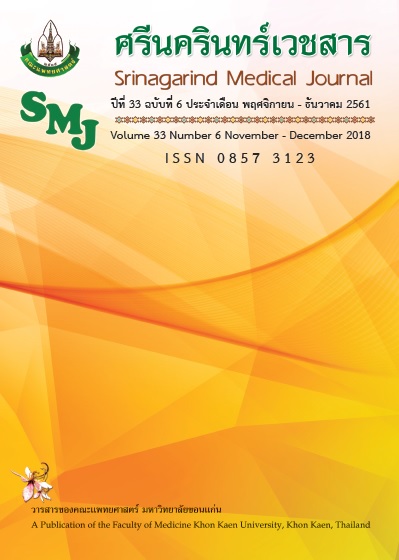The Optimal Region for Occipital Screw Placement: Computed Tomography Analysis of Occipital Bone Thickness
Keywords:
morphological analysis; occipital bone; occipitocervical fusion; thicknessAbstract
Background and Objective: Occipitocervical fusion (OCF) has been used to treat instability and deformity of the craniocervical junction. This specific area requires detail of morphologic knowledge to prevent surgical complications, the most important factor is thickness of occipital bone which is poorly documented in Thai population. The aim of this study was to determine the area of screw placement for optimal fixation in Thai population.
Methods: Thai patients without head and neck disease who underwent CT brain at our hospital in 2016 were included. The thickness of occipital bone was measured based on CT by using external occipital protuberance (EOP) for the reference point. Measurements were taken according to matrix of 153 points following a grid with 5 mm spacing.
Results: 97 patients, composed of 50 males and 47 females were the subjects of this study. Male tended to have a thicker occipital bone than female but no significant differences. The EOP had the greatest thickness, with average values of 17.4 ±2.5 mm (12.9-23.7mm). Areas with thicknesses > 8 mm were more frequent at the EOP and up to 25 mm laterally both sides, as well as up to 20 mm laterally both sides at a level of 5 mm inferior to EOP, up to 10 mm laterally both sides at a level of 10 mm inferior to EOP and up to 35 mm inferior to EOP in the midline.
Conclusions: The results of this first study in Thai population suggest that it is possible to effectively and safety insert screws over wider area than the previous reference range, thus reducing the risk of fixation failure and other complications.
References
2. Deutsch H, Haid RW Jr, Rodts GE Jr, Mummaneni PV. Occipitocervical fixation: Long term results. Spine (Phila Pa 1976) 2005; 30: 530-5.
3. Hsu YH, Liang ML, Yen YS, Cheng H, Huang CI, Huang WC. Use of screw-rod system in occipitocervical fixation. J Chia Med Assoc 2009; 72: 20-8.
4. Haher TR, Yeung AW, Caruso SA, Merola AA, Shin T, Zipnick RI, et al. Occipital screw pullout strength: A biomechanical investigation of occipital morphology. Spine (Phila Pa 1976) 1999; 24: 5-9.
5. Lee SC, Chen JF, Lee ST. Complications of fixation to the occiput-anatomical and design implications. Br J Neurosurg 2004; 18: 590-7.
6. Heywood AW, Learmonth ID, Thomas M. Internal fixation for occipito-cervical fusion. J Bone Joint Surg Br 1988; 70: 708-11.
7. Ebraheim NA, Lu J, Biyani A. An anatomic study of the thickness of the occipital bone: Implications for occipitocervical instrumentation. Spine 1996; 21: 1725-30.
8. Grob D, Dvorak J, Panjabi M, Froehlich M, Hayek J. Posterior occipitocervical fusion. A preliminary report of a new technique. Spine (Phila Pa 1976) 1991; 16(suppl 3): S17-24.
9. Hertel G, Hirschfelder H. In vivo and in vitro CT analysis of the occiput. Eur Spine J 1999; 8: 27-33.
10. King NK, Rajendra T, Ng I, Ng WH. A computed tomography morphometric study of occipital bone and C2 pedicle anatomy for occipital-cervical fusion. Surg Neurol Int 2014; 5: S380-3.
11. Morita T, Takebayashi T, Takashima H, Yoshimoto M, Ida K, Tanimoto K. Mapping occipital bone thickness using computed tomography for safe screw placement. J Neurosurg Spine 2015; 23: 254-8.
12.Naderi S, Usal C, Tural AN, Korman E, Mertol T, Arda MN. Morphologic and radiologic anatomy of the occipital bone. J spinal Disord 2001; 14: 500-3.
13. Zipnick RI, Merola AA, Group J, Kunkle K, Shin T, Caruso SA, et al. Occipital morphology: An anatomic guide to internal fixation. Spine (Phila Pa 1976) 1996; 21: 1719-24.



